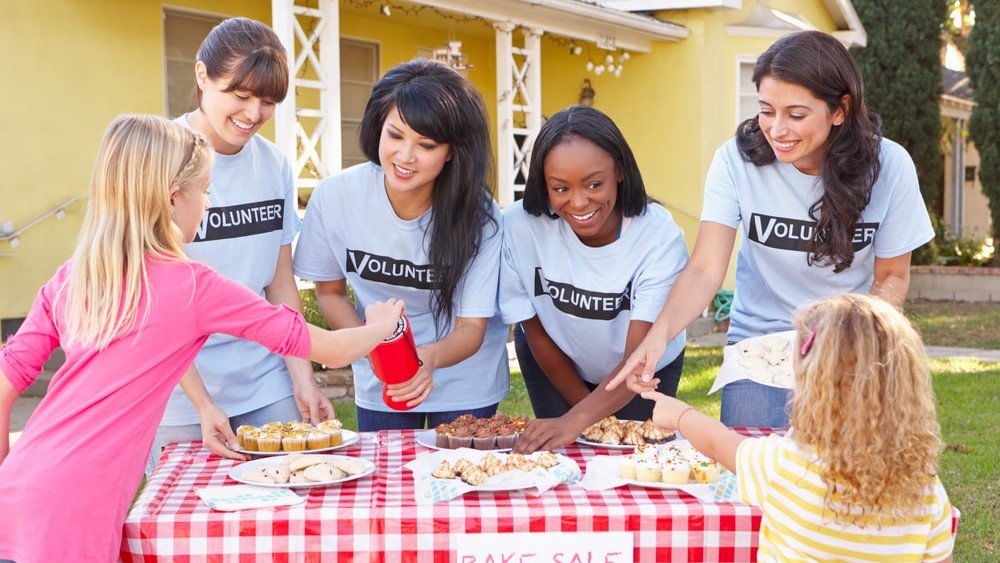
This year’s Nonprofit Social Media Summit was a success! Julia Campbell’s schedule was jam-packed with inspiring sessions. Whether you attended Samantha Vlasceanu’s session on using TikTok, dug into internal communications with Cierra Selby, or explored the best strategies for working with creatives, every minute of the event was an opportunity to learn something new about social media for nonprofits.
It would take ages to share all the fantastic takeaways from the event. Here are five of our favorites.
1. Takeaway: Social Media Doesn’t Exist in a Vacuum
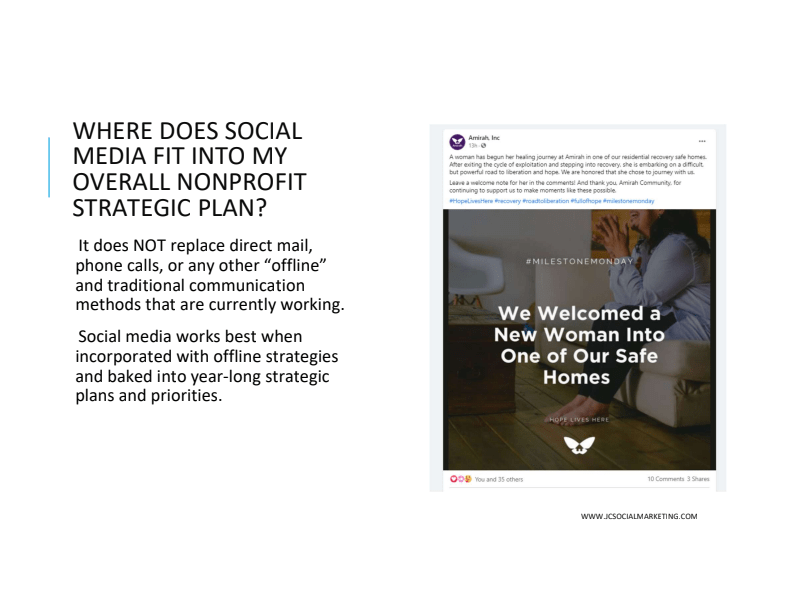
In her session Social Media Marketing in 20 Minutes Per Day, Julia Campbell shared insightful tips for managing your social media presence. While a portion of the presentation reviewed some current social media trends that are especially relevant to fundraisers, Julia was careful to reiterate that social media itself isn’t a trend—it’s here to stay. Your activities on your different social channels will be most effective if they complement your other donor communications. While maintaining a presence on these different platforms is important, it doesn’t reduce the significance of other types of communication like email, phone calls, and direct mail. Your donors almost certainly engage with you on multiple channels, including your social channels. Sharing your messaging across every channel will create a consistent experience for your supporters.
How to Apply This at Your Organization
Plan your social media strategy in conjunction with the rest of your communications. You’ll have an easier time sharing consistent messaging, engaging your donors, and building a thriving community of supporters.
2. Takeaway: Even Small Nonprofits Can Benefit from Facebook Ads
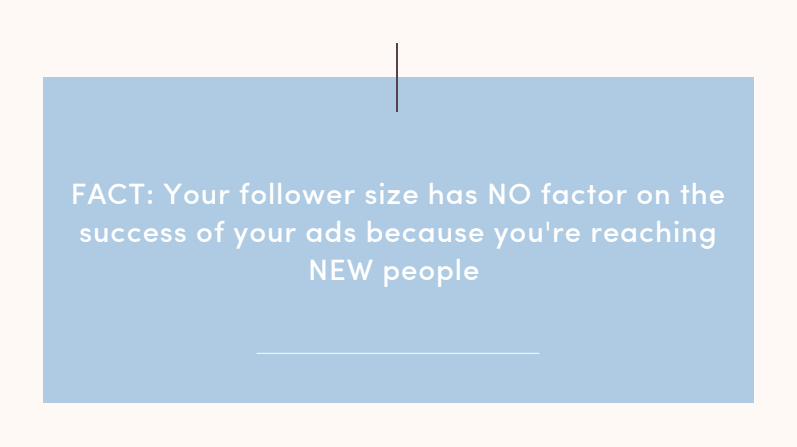
Dana Snyder’s session Prime Your Facebook Audience Now for GivingTuesday and Year-End Success explored how nonprofits can use Facebook ads to build excitement around their year-end fundraising campaigns. You may be thinking, “Facebook ads? As a way to raise money? Is that reasonable?”
Yes! Think about how much you spend, on average, to acquire a donor. Imagine you spend around $40 per new donor. That doesn’t include the number of hours you spend writing emails, running events, or planning direct mail campaigns. What’s your return on that investment? On the other hand, imagine you spend $100 to run a Facebook ad. Your ad gets several hundred views. All you need to do is turn three of those viewers to make a gift, and your donor acquisition cost is lower than the $40 you spent on other channels.
Some small nonprofits may feel that they’re too small to justify running Facebook ads, but the opposite is true. Running ads can be a powerful way to reach new audiences, generate brand awareness, and inspire new supporters to get involved with your work.
How to Apply This at Your Organization
If you’re looking to raise your visibility on Facebook—especially if you’re a smaller nonprofit or are new to the space—consider running some ads. It can be a cost-effective way to gain new followers and grow your donor base.
3. Takeaway: It’s Time to Embrace Resharing Your Content
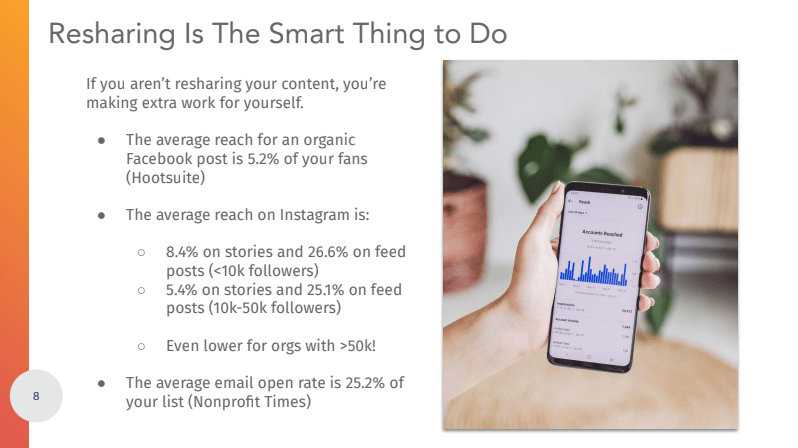
Abby Jarvis (hey, that’s me!) presented Play It Again, Sam: How (and Why) to Create Content You Can Share & Share Again. The whole session centered on planning versatile content that works on a variety of platforms and has great reshare value. The first part of the session focused on establishing why resharing content is such an important strategy, with the primary reason being that most nonprofits’ followers won’t see everything they post. The average reach for organic Facebook posts is just over 5%, and Instagram stories reached a little over 8% of followers. Instagram feed posts reach over 26% of followers, and those numbers go down the bigger the nonprofit’s audience.
Lots of nonprofit fundraisers or marketers worry about resharing their content. These numbers prove that many of your followers don’t see everything you post—and that means there are lots of opportunities for you to repurpose past content for future audiences.
How to Apply This at Your Organization
Plan content with resharing in mind. Create long-form content like blog articles, interviews, and impact updates on your website. As you work on that content, collect images, videos, and other assets you can use to catch donors’ attention and inspire them to read your posts.
When it’s time to share what you’ve written, come up with several different post formats you can use to drive traffic to your article. Try serializing your content or using excerpts, snippets, and quotes as your social media posts. Accompany each post with one of your other assets, and make sure you include a link so people can read more. This system will let you create a virtually endless number of posts, each of which points readers to your main content.
4. Takeaway: TikTok Isn’t Only for the Kids

TikTok is famous for being one of the most popular apps around today, especially among younger Internet users. But Samantha Vlasceanu’s session TikTok Content Strategy 101 revealed that Gen Z’s favorite app isn’t only for young people. In fact, 400 million people over the age of 30 are active users, and those users spend almost an hour and half a day on the platform. As nonprofits look for new ways to engage their donors online, TikTok is becoming an increasingly important platform.
Facebook, Instagram, LinkedIn, and other popular platforms still have more active weekly users than TikTok. But TikTok users tend to spend more time on that app than they do others, and that means it’s a valuable place to reach new supporters and engage potential donors.
How to Apply This at Your Organization
Are you looking to connect with new potential supporters? Do you have the capacity to get creative on another social media platform? TikTok might be a good place to start. The app’s reputation as a dance-focused channel is starting to change as creators explore how to build different kinds of content on that platform. Generation Z and Millennials spend a great deal of time on this popular platform, which means it’s a valuable way to start building an audience, spreading the word about your cause, and engaging new donors.
5. Takeaway: Stewardship Looks Different for Crypto Donors
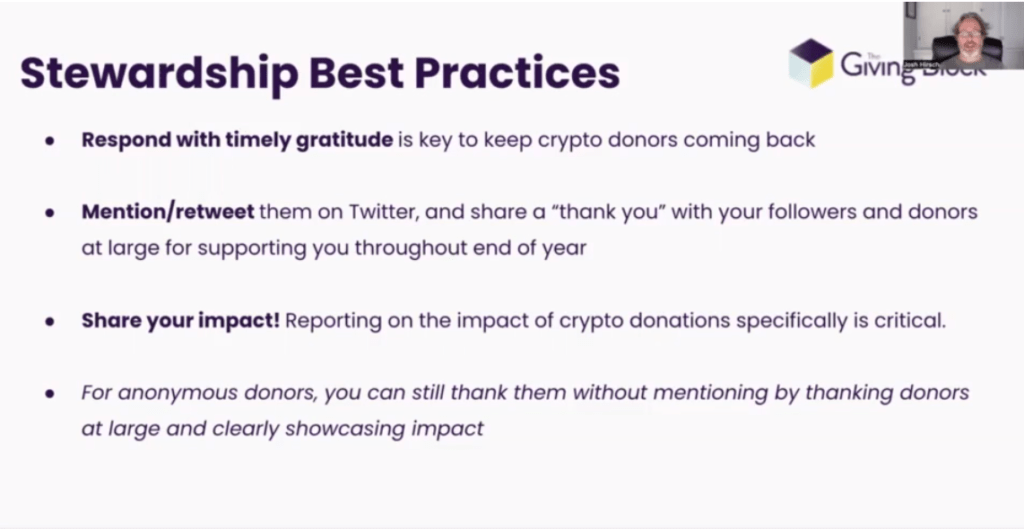
Josh Hirsch’s flash session was a crash course on how crypto philanthropy is impacting the nonprofit sector. One interesting takeaway is that many donors who give cryptocurrency stay anonymous. For fundraisers who understand the significance of donor stewardship, this can initially seem like a problem: How do you steward an anonymous donor?
It’s possible, it just looks a little different from traditional donor stewardship methods. Crypto donors are often active on Twitter; if you know your donor’s Twitter handle, try mentioning them in a thank-you tweet. If they mention your organization on Twitter, re-tweet that post and add a thank-you message there. Sharing crypto donors’ impact specifically is an especially useful tactic, even if those donors opted to stay anonymous. Even thanking anonymous donors on your channels can make a positive impression. As with other stewardship methods, timeliness is key—make a point of showing your gratitude early on.
How to Apply This at Your Organization
If you decide to dive into accepting crypto donations, take some time to think through how you’ll acknowledge this emerging group of donors. Prioritize thanking crypto donors publicly, especially on Twitter, and make sure to periodically share how those donors are making an impact. Even if they never share their names, they’ll know how valuable they are to you.
What Were Your Top Nonprofit Social Media Summit Takeaways?
Julia Campbell’s Nonprofit Social Media Summit was two days of outstanding sessions and workshops. Nonprofit fundraisers and marketers came together to learn, share ideas, and meet one another, and speakers from all kinds of backgrounds shared a broad range of different social media topics.
The Summit may be over, but there are still lots of opportunities to meet other fundraisers and share ideas. Become a part of our Connected Fundraising Slack Community and join hundreds of other nonprofit professionals in a supportive group forum.


